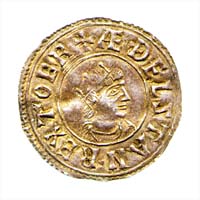July 12, 927: King Æthelstan brings all other British kings under his rule at Eamont
 |
| King Æthelstan, crowned, facing right. Legend: + ÆÐELSTAN REX TO BR |
The Anglo-Saxon Chronicle lists the Celtic rulers (and the one northern Northumbrian English ruler) who submitted to Æthelstan in 927, noting that they established peace with pledge and oaths. A contemporary Latin poem, the Carta dirige gressus, records the spin from the royal court that this was now "perfecta Saxonia", "England made whole". Royal charters, which had from the 890s until 927 used the royal style "King of the Anglo-Saxons" (meaning the West Saxons and the Anglian Mercians), changed to the simpler style "King of the English" (rex Anglorum), and Celtic kings witnessed these charters as "subkings" (subreguli), a clear demonstration of Æthelstan's authority. Æthelstan's coins after 927 often make the same point, with the usual REX expanded to REX TO BR or REX TOT BRIT, for rex totius Britanniae, "King of the Whole of Britain".